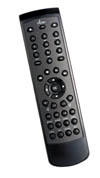Olive Page 2
PERFORMANCE Symphony's audio performance was faultless. In sharp contrast to every other music server (and DVR) I've seen, thanks to its fanless design and tiny, laptop-type hard drive, Symphony is dead silent save for the occasional mouse-scratch of disk-access. It's hard to exaggerate how important this quietness can be - especially for classical listeners.
Discs I ripped using FLAC (Free Lossless Audio Codec), which claims to reduce data by about half without affecting sound quality, sounded identical to the originals. For example, I ripped the Reference Recordings CD of clarinetist Eddie Daniels and the Composers String Quartet playing clarinet quintets of Brahms and Weber. Listening alternately to the imported track and the original, I was completely at a loss to choose between them; even the pianissimo clarinet tones remained free of the telltale burbling and other distortions that "lossy" compression often imposes. This virtue was even audible on pop music - especially material with exposed acoustic piano. On one such piece, Ben Folds's "Brick" from Whatever and Ever Amen, the piano sound managed to avoid the clangorous tinge that muddles many MP3 files.
 Of course, importing music via Symphony's MP3 modes - 128, 160, or 192 kilobits per second (kbps), or variable bit rate - imposed the sonic penalties of the bit rate used. That said, at its highest bit rates MP3 can still sound very close to the original with great space savings, although I wish Olive offered a 320-kbps option. You can also record uncompressed AIFF (CD-audio) and WAV files, at which rate the 80-GB hard drive will accommodate the equivalent of about 125 typical-length CDs. Using FLAC not quite doubles this capacity, while 192-kbps MP3 should fit well over 1,000 CDs worth of music.
Of course, importing music via Symphony's MP3 modes - 128, 160, or 192 kilobits per second (kbps), or variable bit rate - imposed the sonic penalties of the bit rate used. That said, at its highest bit rates MP3 can still sound very close to the original with great space savings, although I wish Olive offered a 320-kbps option. You can also record uncompressed AIFF (CD-audio) and WAV files, at which rate the 80-GB hard drive will accommodate the equivalent of about 125 typical-length CDs. Using FLAC not quite doubles this capacity, while 192-kbps MP3 should fit well over 1,000 CDs worth of music.
Symphony will rip an entire CD from a single keypress, or you can configure it to do so automatically on loading each new disc. My 62-minute Mozart and Weber quintets took about 71/2 minutes to release the Olive's disc drive, though the actual coding (to FLAC or MP3/192) took more than 30 minutes: a fairly leisurely pace compared with a typical computer. Accessing the online Gracenote database, Symphony found disc and track title and artist info for every "normal" CD I threw at it, including some pretty obscure ones, in under a minute. However, most of my contemporary classical recordings - some admittedly very obscure - stumped it. If you don't have broadband access, Symphony includes a substantial subset of the database on its hard drive, and Olive will send quarterly CD-ROM updates in the mail.
EASE OF USE The "widescreen" LCD on Symphony's front panel is handsome, sharp, and readable, and the graphic design and structure of the menu system will feel familiar to anyone who has used an iPod. Dual-concentric jog/shuttle wheels are used to access, scroll, and select. The supplied remote control has only a four-way cursor/enter key set for these functions.
I found using Symphony easy and pleasant; rarely did I have to consult the extensive manual. Assembling playlists, though requiring far more scrolling and keypressing than simply dragging 'n' dropping, was clear and intuitive. And there are scads of other nifty features. For instance, during playback the inner control wheel becomes a true "scrub-wheel," rapidly fast-forward/reversing through the track to your desired spot. Another: under the Play Mode menu you can engage one of three dynamic compression settings, including an Expert Mode that dials up pro parameters like attack time and dynamics-squeezing ratio. A third: Symphony can access Internet radio stations - with all the attendant joys of low-bit-rate/low-fi audio streams, el-weirdo programming, and intermittent lockups. (To be fair, I found several decent-sounding streams among the Olive's Shoutcast-enabled smorgasbord.)
- Log in or register to post comments



































































